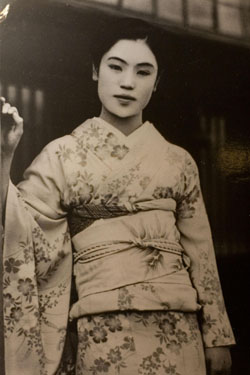川端康成(かわばたやすなり)がとてもすきです。かれは雪国(ゆきぐに)をかいた、雪国はいいほんです。そして、ふるいほんです。わたしはにほんごをよみませんでした。でも、ちゅうごくごのほんやくとえいごのほんやくをよみました。雪国はとてもうつくしいです。雪国もとめもつうれつです。ほんとにすきです。
雪国
川端康成
松栄(駒子のモデル)
Matsuei (onsen geisha on which the character Komako was based)
I once wrote about Snow Country for Columbia adcoms. For the English readers:
“Beauty is that which induces pleasure.” As soon as Mr. Pirie introduced Kierkegaard’s position on beauty in that cozy afternoon class, I knew Kierkegaard would’ve been my perfect reading buddy. I seek nothing but beauty when reading for pleasure, and Snow Country by Yasunari Kawabata is the most meaningful novel I’ve read because it’s the most beautiful.
Kawabata tells a simple tale free of contrivances. Painting the image of a hot spring town in wintertime with delicate brushstrokes, he immerses me in the surreal beauty of snow country. His economy of language and accretion of details infuses the detached narrative with an intangible force, dragging me into a torrent of poignancy. As protagonist Shimamura vacillates between rational judgment and emotional impulse in his fragile affair with Komako, an onsen geisha who despite her identity emanates the purity of snow under Kawabata’s pen, I can’t help but feel Shimumura’s delicious torment.
Kawabata brands “wasted effort” on the hopeless infatuation between Shimamura and Komako time and again, but as much as I am saddened by their inevitable parting, I am roused by their fervent pursuit of beauty. The relationship. Shimamura’s unpublished essays on occidental ballet. Komako’s learning samisen from the radio. So what if nothing is accomplished? The beauty experienced in the process, albeit ephemeral, is real.
Generations of mathematicians spent their lives parsing the mystery of the Riemann Hypothesis and failed. The novel’s translator Edward Seidensticker, who taught alongside Donald Keene until retiring in 1985, admitted flawless translation is impossible. Yet in their lifelong pursuit of beauty, these people found fulfilment that transcended the ends they never achieved.
Through a novel beautiful in itself, Kawabata inspires me to pursue beauty in life without dwelling on the possibility of failure. There’s not enough time for hesitation.


